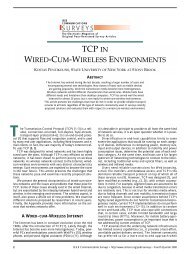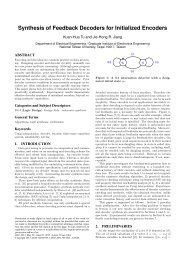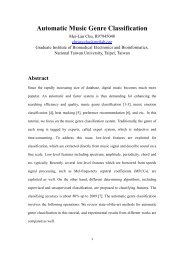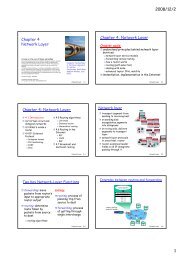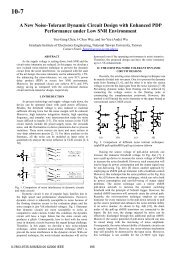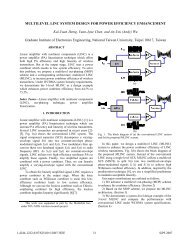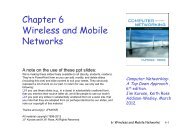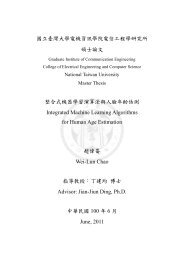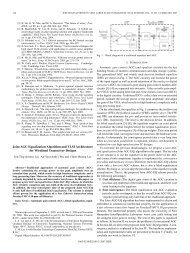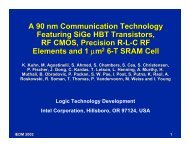Bounds on the undetected error probabilities of linear ... - IEEE Xplore
Bounds on the undetected error probabilities of linear ... - IEEE Xplore
Bounds on the undetected error probabilities of linear ... - IEEE Xplore
You also want an ePaper? Increase the reach of your titles
YUMPU automatically turns print PDFs into web optimized ePapers that Google loves.
<strong>IEEE</strong> TRANSACTIONS ON INFORMATION THEORY, VOL.. 36, NO. 5, SEPTEMBER 1990 1139<br />
[XI<br />
[9]<br />
[IO]<br />
[Ill<br />
R. M. Gray, "Time-invariant trellis encoding <strong>of</strong> ergodic discrete-time<br />
sources with a fidelity criteri<strong>on</strong>," <strong>IEEE</strong> Truns. Inform. Theory, vol.<br />
IT-23, pp. 71-83, Jan. 1977.<br />
A. C. Goris and J. D. Gibs<strong>on</strong>, "Incremental tree coding <strong>of</strong> speech,"<br />
<strong>IEEE</strong> Truns. Inform. Theory, vol. IT-27, pp. 511-516, July 1981.<br />
A. M. Mood and F. A. Graybill, Inrroducti<strong>on</strong> to <strong>the</strong> Theop <strong>of</strong> Statistics,<br />
sec<strong>on</strong>d ed. New York: McGraw-Hill, 1963.<br />
S. Mohan, D. Kryskowski, and C.-M. Lin, "Stack algorithm speech<br />
encoding with fixed and variable symbol release rules," <strong>IEEE</strong> Trans.<br />
Commun., vol. COM-33, pp. 1015-1018, Sept. 1985.<br />
<str<strong>on</strong>g>Bounds</str<strong>on</strong>g> <strong>on</strong> <strong>the</strong> Undetected Error Probabilities <strong>of</strong><br />
Linear Codes for Both Error Correcti<strong>on</strong><br />
and Detecti<strong>on</strong><br />
MAO-CHAO LIN<br />
Abstract -The (n, k, d 2 2t + 1) binary <strong>linear</strong> codes are studied, which<br />
are used for correcting <strong>error</strong> patterns <strong>of</strong> weight at most t and detecting<br />
o<strong>the</strong>r <strong>error</strong> patterns over a binary symmetric channel. In particular, for<br />
t = 1, it is shown that <strong>the</strong>re exists <strong>on</strong>e code whose probability <strong>of</strong> <strong>undetected</strong><br />
<strong>error</strong>s is upper bounded by (n + 1]2"-k - n]-l when used <strong>on</strong> a<br />
binary symmetric channel with transiti<strong>on</strong> probability less than 2/n.<br />
I. INTRODUCTION<br />
In pure ARQ systems, <strong>linear</strong> codes are used solely for detecting<br />
<strong>error</strong>s. Suppose that we apply <strong>linear</strong> codes to a binary<br />
symmetric channel (BSC) with transiti<strong>on</strong> probability p. It 11, pp.<br />
78-79] has been proved that for each p with 0 I p I 1, <strong>the</strong>re<br />
exists an (n,k) binary <strong>linear</strong> code whose probability <strong>of</strong> <strong>undetected</strong><br />
<strong>error</strong>s (PUDE) is upper bounded by 2-(n-k). Hamming<br />
codes and double <strong>error</strong> correcting primitive BCH codes [2],[3]<br />
have been proved to satisfy <strong>the</strong> inequality if <strong>the</strong> transiti<strong>on</strong><br />
probability p is no greater than 1/2.<br />
Pure ARQ systems have <strong>the</strong> problem <strong>of</strong> low throughput if <strong>the</strong><br />
transiti<strong>on</strong> probability in <strong>the</strong> BSC is high. Therefore, in hybrid<br />
ARQ systems [l] especially in type-I hybrid ARQ systems, <strong>linear</strong><br />
codes are used for correcting some low weight <strong>error</strong> patterns<br />
and detecting many o<strong>the</strong>r <strong>error</strong> patterns. Therefore, it is interesting<br />
to study <strong>the</strong> probability <strong>of</strong> <strong>undetected</strong> <strong>error</strong>s for <strong>linear</strong><br />
codes that are used for both <strong>error</strong> correcti<strong>on</strong> and <strong>error</strong> detecti<strong>on</strong><br />
over <strong>the</strong> BSC. In this corresp<strong>on</strong>dence, our study is divided<br />
into two parts. In <strong>the</strong> first part, we study <strong>the</strong> class <strong>of</strong> (n, k, d 2 3)<br />
systematic <strong>linear</strong> codes that can be used for correcting every<br />
single <strong>error</strong> and detecting o<strong>the</strong>r <strong>error</strong> patterns. We show that<br />
<strong>the</strong>re exists <strong>on</strong>e code whose PUDE is upper bounded by (n + 1)<br />
.[2n-k- n]-l when <strong>the</strong> transiti<strong>on</strong> probability is less than 2/n.<br />
In <strong>the</strong> sec<strong>on</strong>d part, we study <strong>the</strong> (n,k) systematic <strong>linear</strong> codes<br />
that are used for correcting some low weight-<strong>error</strong> patterns and<br />
detecting o<strong>the</strong>r <strong>error</strong> patterns. Suppose that 1 - R > H(2A). We<br />
show that <strong>the</strong>re exists an (n, Rn,d 2 2An + 1) <strong>linear</strong> code whose<br />
PUDE is closely upper bounded by 2-['-R-H'A)]n as n approaches<br />
infinity and <strong>the</strong> transiti<strong>on</strong> probability is less than A (if<br />
it is used to correct all <strong>the</strong> <strong>error</strong> patterns <strong>of</strong> weight at most An<br />
and to detect o<strong>the</strong>r <strong>error</strong> patterns).<br />
11. CODES FOR ERROR DETECTION<br />
SINGLE-ERROR CORRECTION<br />
AND<br />
C<strong>on</strong>sider <strong>the</strong> ensemble r <strong>of</strong> all systematic (n, k, d 2 3) binary<br />
<strong>linear</strong> codes. The generator matrix <strong>of</strong> an (n, k) systematic <strong>linear</strong><br />
code V is <strong>of</strong> <strong>the</strong> form G = [ I PI, where I is <strong>the</strong> k X k identity<br />
matrix and P is some k(n - k) matrix. A necessary and sufficient<br />
c<strong>on</strong>diti<strong>on</strong> for V to have minimum distance <strong>of</strong> at least 3 is<br />
that no two rows <strong>of</strong> P are identical and each row in P must<br />
have weight <strong>of</strong> at least 2. Therefore, <strong>the</strong> cardinality <strong>of</strong> r is<br />
iri = [ 2" - k - 1 - ( - k)] . [ 2" -k - 1 - (. - k ) - 11<br />
. . . [2"-k - 1 -(n - k) -(k - l)]<br />
[ 2" - - 1 - ( n - k )] !<br />
- .<br />
[2n4- 1 - n]!<br />
We denote <strong>the</strong> codes in r by VI, V,;. .,Tr,. Let Al., be <strong>the</strong><br />
number <strong>of</strong> weight-w codewords in v, where I = 1,2; .., Irl, and<br />
w = 0,3,4,. . . , n. Suppose v is used to correct every single <strong>error</strong><br />
and detect o<strong>the</strong>r <strong>error</strong> patterns over a BSC with transiti<strong>on</strong><br />
probability p, its PUDE is<br />
n<br />
JTEIv) = c [(w + l).A,,,+I + AI,, +(n - w + l ).~,,w-l]<br />
w=2<br />
(1)<br />
.PW(1 - p)"- W. (2)<br />
If <strong>the</strong> probability <strong>of</strong> choosing each code in r is equally likely,<br />
<strong>the</strong> average PUDE over all <strong>the</strong> codes in r is<br />
Note that each n<strong>on</strong>zero n-tuple appears in at most Ir'l codes in<br />
r, where<br />
ir'i I [2n-k- I-(~<br />
- k)] -I-(~- k)-i]<br />
. . . [2n-k - 1 - (n - k ) - ( k -2)]<br />
12n-k - 1 -(n - k)l !<br />
(4)<br />
Manuscript received February 8, 1989; revised December 1, 1989. This<br />
work was presented at <strong>the</strong> <strong>IEEE</strong> 1990 Internati<strong>on</strong>al Symposium <strong>on</strong> Informati<strong>on</strong><br />
Theory, San Diego, CA, January 14-19, 1990. This work was supported<br />
by <strong>the</strong> Nati<strong>on</strong>al Science Council <strong>of</strong> <strong>the</strong> Republic <strong>of</strong> China under grant NSC<br />
78-0404-E002-05.<br />
M.-C. Lin is with <strong>the</strong> Department <strong>of</strong> Electrical Engineering, Nati<strong>on</strong>al<br />
Taiwan University, Taipei 10764, Taiwan, ROC.<br />
<strong>IEEE</strong> Log Number 9036388.<br />
0018-9448/90/0900-1139$01.00 01990 <strong>IEEE</strong>
1140 <strong>IEEE</strong> TRANSACTIONS ON INFORMATION THEORY, VOL. 36, NO. 5, SEPTEMBER 1990<br />
with<br />
codes in rD, <strong>the</strong>n<br />
Combining (4)-(7) we have<br />
ir'i<br />
iri<br />
P(E) I - (n+l)<br />
n+l<br />
I 2"-k.<br />
It follows from (8) that, for each p, <strong>the</strong>re exists a code in r<br />
whose PUDE is at most n + 1/2"-k - n. Note that <strong>the</strong> term<br />
~"'(1- is an increasing functi<strong>on</strong> <strong>of</strong> p if p I w/n. Hence,<br />
PI"-"<br />
for each code y in I', P(EIy) is an increasing functi<strong>on</strong> <strong>of</strong> p if<br />
p I 2/n. Therefore, we see that <strong>the</strong>re exists at least <strong>on</strong>e code in<br />
r such that its PUDE is upper bounded by<br />
(8)<br />
f m<br />
= 2 c ,e(;)(:)(;:)<br />
w=Dm=Oi=O<br />
.PW<br />
+m - 2r<br />
(1 - p )n -w -m +2i<br />
111. CODES FOR ERROR DETECTION AND<br />
MULTIPLE-ERROR CORREC~ION<br />
The ensemble <strong>of</strong> all <strong>the</strong> systematic (n, k) <strong>linear</strong> codes c<strong>on</strong>tains<br />
2k(n-k) distinct codes while at most<br />
= w 5 =Dm=O i (;)E(:)(:) i=O<br />
<strong>of</strong> <strong>the</strong>m c<strong>on</strong>tain n<strong>on</strong>zero codewords <strong>of</strong> weight less than d. Thus,<br />
<strong>the</strong> ensemble <strong>of</strong> all <strong>the</strong> systematic (n,k,d 2 D) <strong>linear</strong> codes rD<br />
c<strong>on</strong>tains<br />
distinct codes. Let V, be a code in r,, and let A/,,, be <strong>the</strong><br />
number <strong>of</strong> codewords <strong>of</strong> weight w in 5, where 1 = 1,2; . ., lrDl.<br />
Assume D = 2t + 1. If V, is used for correcting all <strong>the</strong> <strong>error</strong><br />
patterns <strong>of</strong> weight no more than t and detecting o<strong>the</strong>r <strong>error</strong><br />
patterns, <strong>the</strong>n its PUDE [4] is<br />
n I min(t-i,n-w)<br />
P(EIV,)= c 4 . w c c<br />
w=D i=O j=O<br />
(3<br />
If we define as zero for i > n or i < 0, <strong>the</strong>n we can replace<br />
<strong>the</strong> index term <strong>of</strong> min(t - i, n - w) in (10) by t - i. If each code<br />
in rD is selected equally likely, by taking <strong>the</strong> average <strong>of</strong> (10) over<br />
Thus<br />
I<br />
= c (;).<br />
m=O<br />
I<br />
lf'l m=O (2<br />
(y)<br />
~(E)I- (;)< D-l . (14)<br />
IrDl m = 0<br />
2"-k-<br />
This shows <strong>the</strong> existence <strong>of</strong> a code in rD with PUDE upper<br />
bounded by (14) for p I (t + l)/n. If we take D to be 3, (14)<br />
does not reduce to (8), since here we use a looser bound in<br />
estimating <strong>the</strong> size <strong>of</strong> <strong>the</strong> ensemble <strong>of</strong> codes. Note that <strong>the</strong><br />
requirement <strong>of</strong> 2"-k - n > 0 in (8) is a necessary and sufficient<br />
c<strong>on</strong>diti<strong>on</strong> for <strong>the</strong> existence <strong>of</strong> (n,k) binary <strong>linear</strong> codes <strong>of</strong><br />
distance <strong>of</strong> at least 3, while <strong>the</strong> requirement <strong>of</strong><br />
D-I<br />
i=O<br />
i=O
<strong>IEEE</strong> TRANSACTIONS ON INFORMATION THEORY, VOL. 36, NO. 5, SEPTEMBER 1990<br />
I141<br />
in (14) is <strong>on</strong>ly a sufficient c<strong>on</strong>diti<strong>on</strong> for <strong>the</strong> existence <strong>of</strong> (n, k)<br />
binary <strong>linear</strong> codes <strong>of</strong> distance at least D. From (14), we note<br />
that if<br />
is substantially smaller than 2“-& <strong>the</strong>n <strong>the</strong>re exists an (n, k)<br />
code in r, whose PUDE is closely upper bounded by<br />
This result agrees with our intuiti<strong>on</strong>, since this PUDE is <strong>the</strong><br />
probability <strong>of</strong> <strong>error</strong> patterns which bel<strong>on</strong>g to i) cosets <strong>of</strong><br />
<strong>the</strong> standard array for a <strong>linear</strong> code as p = 1/2.<br />
Now we want to examine <strong>the</strong> behavior <strong>of</strong> PUDE when n<br />
approaches infinity. Let t = An, k = Rn, where 0 < A < 1/4.<br />
Then, D - 1 = 2An. It [5] can be shown that<br />
and<br />
New Results <strong>on</strong> Self-Orthog<strong>on</strong>al Unequal Error<br />
Protecti<strong>on</strong> Codes<br />
ZHI CHEN, PINGZHI FAN, AND FAN JIN<br />
Abstract -A lower bound <strong>on</strong> <strong>the</strong> length <strong>of</strong> binary self-orthog<strong>on</strong>al<br />
unequal <strong>error</strong> protecti<strong>on</strong> (UEP) codes is derived, and two design _. procedures<br />
for c<strong>on</strong>structing optimal self-orthog<strong>on</strong>al UEP codes are proposed.<br />
Using this bound, we comment <strong>on</strong> some known codes.<br />
I. INTRODUCTION<br />
In data transmissi<strong>on</strong> and processing, <strong>error</strong>-correcting codes<br />
can provide efficient <strong>error</strong> protecti<strong>on</strong>. But in many applicati<strong>on</strong>s,<br />
not all digits are equally important, and <strong>error</strong>s in more important<br />
digits are more serious than those in less important digits.<br />
Thus, it is appropriate to use codes with unequal <strong>error</strong> protecti<strong>on</strong><br />
capability.<br />
Since such codes were first introduced by Masnick and Wolf<br />
[l], many results have been achieved [2], [3]. Usually, a decoding<br />
algorithm for such a code is complicated, so it is necessary to<br />
design UEP codes which can be implemented easily. Selforthog<strong>on</strong>al<br />
UEP codes are <strong>the</strong>refore introduced. We first derive<br />
a lower bound for such codes, and <strong>the</strong>n propose hvo procedures<br />
for c<strong>on</strong>structing codes that are optimal am<strong>on</strong>g <strong>the</strong> systematic<br />
self-orthog<strong>on</strong>al UEP codes. Comparis<strong>on</strong> with known codes [4] is<br />
also given.<br />
where H(A)= -Alog,A -(l-A)Iog,(l-A). Thus<br />
2H(A)n<br />
2(1-R)n -2H(ZA)n ’<br />
If H(2A) < 1 - R, as n approaches infinity, (17) becomes<br />
(17)<br />
11. LOWER BOUND FOR SELF-ORTHOGONAL UEP CODES<br />
Definiti<strong>on</strong> 1: For a <strong>linear</strong> [n,k] code C over <strong>the</strong> alphabet<br />
GF(q), <strong>the</strong> separati<strong>on</strong> vector S(G) = (S(G),, S(G),; . .,S(G),)<br />
<strong>of</strong> length k, with respect to a generator matrix G <strong>of</strong> C, is<br />
defined by<br />
Hence, we show that for <strong>the</strong> ensemble <strong>of</strong> <strong>linear</strong> codes <strong>of</strong> length<br />
n, which are used for correcting all <strong>the</strong> <strong>error</strong> patterns <strong>of</strong> weight<br />
no more than An and detecting o<strong>the</strong>r <strong>error</strong> patterns, <strong>the</strong>re exists<br />
at least <strong>on</strong>e code such that its PUDE is upper bounded by<br />
2-[1-R-H(A)1n as n approaches infinity, if 1 - R > H(2A) and<br />
p I A. It is interesting to see that for each transmissi<strong>on</strong> <strong>of</strong> such a<br />
code, <strong>the</strong> probability <strong>of</strong> acceptance by <strong>the</strong> receiver is<br />
P(A) 2 1 -<br />
w=An+l<br />
(;).pyl-p)n-W.<br />
Using <strong>the</strong> inequality (A.6) in [6], (19) yields<br />
P( A) 2 1 - (( p/A)’[( 1 - A)/(l- p)]I-*]”, for p < A.<br />
REFERENCES<br />
S. Lin and D. J. Costello, Jr., “Error C<strong>on</strong>trol Coding: Fundamentals and<br />
Applicari<strong>on</strong>s. Englewood Cliffs, NJ: Prentice-Hall.<br />
S. K. hung-Yan-Che<strong>on</strong>g and M. E. Hellman, “C<strong>on</strong>cerning a hound <strong>on</strong><br />
<strong>undetected</strong> <strong>error</strong> probability,” <strong>IEEE</strong> Trans. Inform. Theory, vol. IT-22,<br />
pp. 235-237, 1976.<br />
S. K. Lung-Yan-Che<strong>on</strong>g, E. R. Barnes, and D. U. Friedman, “On some<br />
properties <strong>of</strong> <strong>the</strong> <strong>undetected</strong> <strong>error</strong> <strong>probabilities</strong> <strong>of</strong> <strong>linear</strong> codes,” <strong>IEEE</strong><br />
Trans. Inform. Theory, vol. IT-25, pp. 110-112, Jan. 1979.<br />
R. H. Deng and D. J. Costello, Jr., “Reliability and throughput analysis<br />
<strong>of</strong> a c<strong>on</strong>catenated coding scheme,” <strong>IEEE</strong> Trans. Commun., vol. COM-35,<br />
pp. 698-705, July 1987.<br />
F. J. MacWilliams and N. J. A. Sloane, “The Theory <strong>of</strong> Error-Correcting<br />
Codes. New York: North-Holland.<br />
W. W. Peters<strong>on</strong> and E. J. Weld<strong>on</strong>, Jr., Error-Cotrecting Codes, 2nd ed.<br />
Cambridge, MA: MIT Press, 1972.<br />
(18) S(G), = min(wt(mG)lm EGF(q)k,m, # O}, i = 1,2;..,k.<br />
0018-9448/90/0900-1141$01.00 01990 <strong>IEEE</strong><br />
The parameters <strong>of</strong> such a code are usually written as [n, k, S(G)]<br />
and, in general, depend <strong>on</strong> <strong>the</strong> particular choice <strong>of</strong> <strong>the</strong> generator<br />
matrix G as well as <strong>on</strong> C.<br />
Given a binary [n, k] code, if <strong>the</strong> parity check rules are chosen<br />
such that no two codeword digits appear toge<strong>the</strong>r in more than<br />
<strong>on</strong>e parity-check equati<strong>on</strong>, <strong>the</strong>n <strong>the</strong> code is said to be selforthog<strong>on</strong>al<br />
(in this corresp<strong>on</strong>dence, we examine self-orthog<strong>on</strong>al<br />
codes in this sense, see also Massey [5]). In additi<strong>on</strong>, if <strong>the</strong><br />
message digit m, in such a code is checked by at least J, parity<br />
check digits, <strong>the</strong>n <strong>the</strong> comp<strong>on</strong>ent s, <strong>of</strong> <strong>the</strong> separati<strong>on</strong> vector <strong>of</strong><br />
<strong>the</strong> code is at least J, +l. For a self-orthog<strong>on</strong>al UEP code, <strong>the</strong><br />
message digit m, can be protected against LJ, /2] <strong>error</strong>s with <strong>the</strong><br />
majority logic decoding algorithm.<br />
In many practical applicati<strong>on</strong>s, it is more c<strong>on</strong>venient to use<br />
<strong>the</strong> following definiti<strong>on</strong> to describe UEP codes.<br />
Definiti<strong>on</strong> 2: R = (rl, r,,. . ., rr and D = (d 1, d,, .. ., d,) are<br />
called <strong>the</strong> code rate vector and distance vector respectively,<br />
where dl;..,dl are distinct, and (d,;..,d,}=(S(G),=s,lj=<br />
1,2;..,k). Let k, be <strong>the</strong> number <strong>of</strong> message digits with <strong>the</strong><br />
same d,, and let r, = k, / n be <strong>the</strong> part code rate, for i =<br />
Manuscript received November 18, 1988; revised January 10, 1990. This<br />
work was supported in part by <strong>the</strong> Nati<strong>on</strong>al Natural Science Foundati<strong>on</strong> <strong>of</strong><br />
China under Grant 6873017.<br />
The authors are with <strong>the</strong> Department <strong>of</strong> Computer Science and Engineering,<br />
Southwest Jiaot<strong>on</strong>g University, Emei, Sichuan 614202, PRC.<br />
<strong>IEEE</strong> Log Number 9035997.



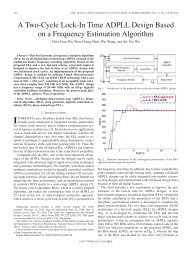
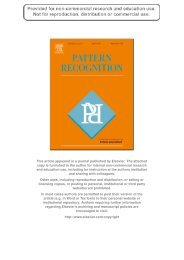
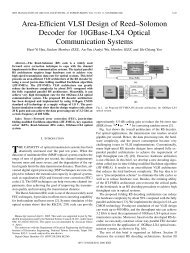
![On [n, n - 1] convolutional codes with low trellis complexity ...](https://img.yumpu.com/45854741/1/190x245/on-n-n-1-convolutional-codes-with-low-trellis-complexity-.jpg?quality=85)
